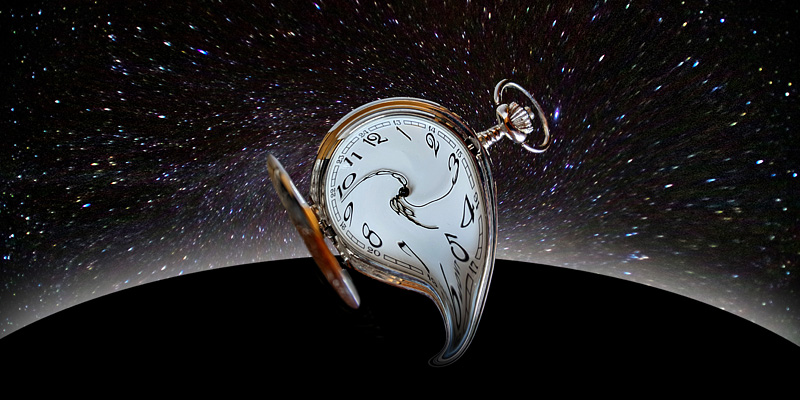The Magic Watch
In a minute I’m going to tell you the only scientifically proven way to stay young (you’re not going to like it though) and I’ll use my magic pocket watch to explain how it works. The watch is indestructible and I always know what time it says no matter how far away it is.
Say I leave my watch at my house by the sea and go live on a high mountain. After a little while I will notice that my magic watch (which I can magically still see) will be running ever so slightly slow compared to my wristwatch. The longer I stay up the mountain, the slower my magic watch will run. Slower by some millionths of a second only but slower. The reason is not the sea air but gravity. Living on a mountain, I am ever so slightly further away from the gravity created by the mass of the Earth while the magic watch – at sea level – is deeper in the Earth’s gravity field and runs slower because time itself runs slower there.
That time moves slower at sea level than on mountaintops sounds like a crazy theory with no practical application but we have hard experimental evidence for time dilation both due to gravity and acceleration (which, according to Einstein, are the same thing). Not only has this been tested with atomic clocks in planes and rockets but you can also see the effect for yourself every day.
Ostensibly designed for the military but really put in orbit so that no man need ever suffer the embarrassment of asking for directions again, the Global Positioning System provides daily proof of the strange tricks gravity plays on time. The GPS satellites have to contend with not one, but two effects of time dilation. First of all, they are moving pretty fast so – compared to a stationary clock – their clocks are ticking more slowly. Not a lot more slowly, about 7 microseconds per day. They are also a lot further away from Earth’s gravity field so they are simultaneously ticking more swiftly that Earthbound clocks. Again, not much – about 45 microseconds per day. A quick calculation shows that each satellite thus runs fast approximately 38 microseconds per day. Not the sort of difference you’d notice on your wristwatch (well, not for a long while anyway) but, if the effect wasn’t corrected for by the GPS system, your location would be out by 7 miles per day. If I spend a lifetime in orbit and leave my magic watch on the ground, it will be running a second slower when I return. The same number of seconds will have passed for both of us it’s just that the earth-bound watch’s seconds are verrrrry slightly longer.
OK, that’s not much of a time saving. To see a bigger effect we’ll need something with higher gravity. You can find plenty of demonstrations on-line with weights on rubber sheets to illustrate the way different masses make larger or smaller dents on spacetime. Earth makes a football size dent, Jupiter and the other gas giant worlds make bowling ball size dents but for real gravity we have to visit the Sun. With something like 28g at the surface, the gravity of the Sun is like throwing an anvil onto the rubber sheet. Left bobbing about the Sun’s surface (and this is where the indestructible part comes in handy) the magic watch will run roughly a minute per year slower there than on Earth. So, if you want to stay young for longer just live on the surface of the Sun! Sure there are a few technical issues to work out but at least you’ll get an even – if extremely brief – tan.

How about something heavier? If a star is big enough when it dies it will collapse into a black hole. A black hole doesn’t just make a dent in the rubbery spacetime sheet, it wraps it tightly around itself like a warm blanket on a winter night. All that material of the star gets herded tighter and tighter together as gravity just squashes everything further and further down. And further. And further. And… well, we don’t currently know of any physical process that would stop the star collapse. When you do the sums, the entire mass of a star ends up infinitely small and infinitely dense. At this point, the laws of physics throw their hands in the air, kick back, crack open a cold one and go ‘whatever dude’. The whole ‘infinite mass in infinitely small space’ problem – referred to as a singularity – is a bit of a predicament for physicists. It’s the cosmological version of the embarrassing relative you don’t mention at family get-togethers. Occasionally there are interventions organised to try and rehabilitate this black sheep. Maybe all that mass spews out somewhere else as a white hole. Maybe some quantum hand-wavey stuff smears out the mass so it’s not quite infinite. Nothing has really taken hold though.
We don’t currently know of any physical process that would stop the star collapse. Or do we? Lets take my magic watch and see what happens if I throw it into a black hole. There are a lot of fun effects we can ignore with the magic watch. Normal matter would be shredded by the intense gravity and light or radio signals would lose energy then wink out altogether as they fell towards the event horizon – the point where gravity becomes too strong to allow light to escape. But what do we see as the watch falls into the black hole? The intense gravity will distort time just as it did around the Earth or the Sun. We’ll see the magic watch’s hands move slower and slower the further down it goes. At some point the pocket watch’s second will be two seconds on our watch, then a minute, then a million years, The closer it gets to the mass of the black hole, the tighter the blanket of space time gets wrapped, the slower time will seem to move. Again, this is only from our perspective. As far as the watch is concerned time is still passing at the usual one second per second and it’s the outside universe that’s starting to speed up. And this is a problem if the watch ever expects to actually get to the black hole because black holes evaporate. It takes trillions and trillions of years but a process discovered by Stephen Hawking (appropriately named Hawking radiation) means that every black hole will loose mass from just above its event horizon until it shrinks and vanishes. The magic watch is falling like a temporal Zeno’s tortoise with each millimetre taking longer than the one before but the Hawking radiation is evaporating the black hole at a fixed rate from the event horizon. From it’s perspective, the watch will see the black hole ageing more and more swiftly as it falls, evaporating faster and faster (since the Hawking radiation, along with the rest of the universe is speeding up). Long before the watch can reach the central singularity, the black hole will evaporate completely and the watch will find itself floating in empty space, trillions of years in the future.
This is just a thought experiment and I don’t actually have a magic watch. But I don’t need one because what would be true for the magic watch is true for the matter of the star collapsing into the black hole. Every quark and electron is collapsing in an ever slower slow motion. Though we will never see it within its cloaking event horizon, every star that has ever collapsed into a black hole is still in the process of collapse. Though black holes can get to arbitrarily high mass densities, the infinite mass in zero volume of a singularity has never been reached because, from the perspective of the outside universe, there simply hasn’t been enough time. In fact, there never will be. Just as with the watch, the higher the mass density goes – the tighter gravity warps its rubbery spacetime blanket – the faster (from it’s perspective) is the evaporation from Hawking radiation. Every black hole is in a race it can never win – doomed by a cosmic time limit it is itself enforcing – to evaporate before ever reaching a point of singularity.



